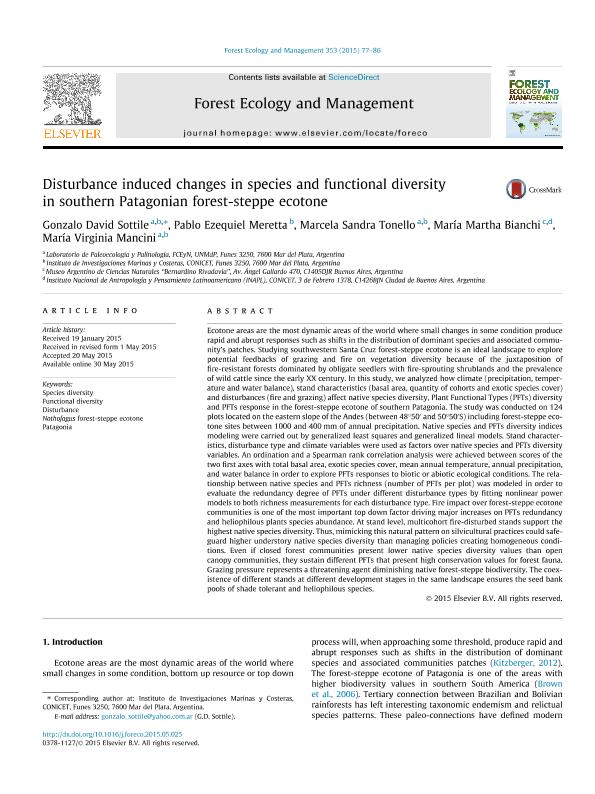Mostrar el registro sencillo del ítem
dc.contributor.author
Sottile, Gonzalo David

dc.contributor.author
Meretta, Pablo Ezequiel

dc.contributor.author
Tonello, Marcela Sandra

dc.contributor.author
Bianchi, Maria Martha

dc.contributor.author
Mancini, Maria Virginia

dc.date.available
2018-06-29T17:11:43Z
dc.date.issued
2015-10
dc.identifier.citation
Sottile, Gonzalo David; Meretta, Pablo Ezequiel; Tonello, Marcela Sandra; Bianchi, Maria Martha; Mancini, Maria Virginia; Disturbance induced changes in species and functional diversity in southern Patagonian forest-steppe ecotone; Elsevier Science; Forest Ecology and Management; 353; 10-2015; 77-86
dc.identifier.issn
0378-1127
dc.identifier.uri
http://hdl.handle.net/11336/50680
dc.description.abstract
Ecotone areas are the most dynamic areas of the world where small changes in some condition produce rapid and abrupt responses such as shifts in the distribution of dominant species and associated community's patches. Studying southwestern Santa Cruz forest-steppe ecotone is an ideal landscape to explore potential feedbacks of grazing and fire on vegetation diversity because of the juxtaposition of fire-resistant forests dominated by obligate seedlers with fire-sprouting shrublands and the prevalence of wild cattle since the early XX century. In this study, we analyzed how climate (precipitation, temperature and water balance), stand characteristics (basal area, quantity of cohorts and exotic species cover) and disturbances (fire and grazing) affect native species diversity, Plant Functional Types (PFTs) diversity and PFTs response in the forest-steppe ecotone of southern Patagonia. The study was conducted on 124 plots located on the eastern slope of the Andes (between 48°50' and 50°50'S) including forest-steppe ecotone sites between 1000 and 400. mm of annual precipitation. Native species and PFTs diversity indices modeling were carried out by generalized least squares and generalized lineal models. Stand characteristics, disturbance type and climate variables were used as factors over native species and PFTs diversity variables. An ordination and a Spearman rank correlation analysis were achieved between scores of the two first axes with total basal area, exotic species cover, mean annual temperature, annual precipitation, and water balance in order to explore PFTs responses to biotic or abiotic ecological conditions. The relationship between native species and PFTs richness (number of PFTs per plot) was modeled in order to evaluate the redundancy degree of PFTs under different disturbance types by fitting nonlinear power models to both richness measurements for each disturbance type. Fire impact over forest-steppe ecotone communities is one of the most important top down factor driving major increases on PFTs redundancy and heliophilous plants species abundance. At stand level, multicohort fire-disturbed stands support the highest native species diversity. Thus, mimicking this natural pattern on silvicultural practices could safeguard higher understory native species diversity than managing policies creating homogeneous conditions. Even if closed forest communities present lower native species diversity values than open canopy communities, they sustain different PFTs that present high conservation values for forest fauna. Grazing pressure represents a threatening agent diminishing native forest-steppe biodiversity. The coexistence of different stands at different development stages in the same landscape ensures the seed bank pools of shade tolerant and heliophilous species.
dc.format
application/pdf
dc.language.iso
eng
dc.publisher
Elsevier Science

dc.rights
info:eu-repo/semantics/openAccess
dc.rights.uri
https://creativecommons.org/licenses/by-nc-sa/2.5/ar/
dc.subject
Disturbance
dc.subject
Functional Diversity
dc.subject
Nothofagus Forest-Steppe Ecotone
dc.subject
Patagonia
dc.subject
Species Diversity
dc.subject.classification
Otras Ciencias Biológicas

dc.subject.classification
Ciencias Biológicas

dc.subject.classification
CIENCIAS NATURALES Y EXACTAS

dc.title
Disturbance induced changes in species and functional diversity in southern Patagonian forest-steppe ecotone
dc.type
info:eu-repo/semantics/article
dc.type
info:ar-repo/semantics/artículo
dc.type
info:eu-repo/semantics/publishedVersion
dc.date.updated
2018-06-29T13:08:16Z
dc.journal.volume
353
dc.journal.pagination
77-86
dc.journal.pais
Países Bajos

dc.journal.ciudad
Amsterdam
dc.description.fil
Fil: Sottile, Gonzalo David. Consejo Nacional de Investigaciones Científicas y Técnicas. Centro Científico Tecnológico Conicet - Mar del Plata. Instituto de Investigaciones Marinas y Costeras. Universidad Nacional de Mar del Plata. Facultad de Ciencia Exactas y Naturales. Instituto de Investigaciones Marinas y Costeras; Argentina. Universidad Nacional de Mar del Plata. Facultad de Ciencias Exactas y Naturales. Laboratorio de Paleoecología y Palinología; Argentina
dc.description.fil
Fil: Meretta, Pablo Ezequiel. Consejo Nacional de Investigaciones Científicas y Técnicas. Centro Científico Tecnológico Conicet - Mar del Plata. Instituto de Investigaciones Marinas y Costeras. Universidad Nacional de Mar del Plata. Facultad de Ciencia Exactas y Naturales. Instituto de Investigaciones Marinas y Costeras; Argentina
dc.description.fil
Fil: Tonello, Marcela Sandra. Consejo Nacional de Investigaciones Científicas y Técnicas. Centro Científico Tecnológico Conicet - Mar del Plata. Instituto de Investigaciones Marinas y Costeras. Universidad Nacional de Mar del Plata. Facultad de Ciencia Exactas y Naturales. Instituto de Investigaciones Marinas y Costeras; Argentina. Universidad Nacional de Mar del Plata. Facultad de Ciencias Exactas y Naturales. Laboratorio de Paleoecología y Palinología; Argentina
dc.description.fil
Fil: Bianchi, Maria Martha. Consejo Nacional de Investigaciones Científicas y Técnicas. Oficina de Coordinación Administrativa Parque Centenario. Museo Argentino de Ciencias Naturales “Bernardino Rivadavia”; Argentina. Secretaría de Cultura de la Nación. Dirección Nacional de Cultura y Museos. Instituto Nacional de Antropología y Pensamiento Latinoamericano; Argentina
dc.description.fil
Fil: Mancini, Maria Virginia. Consejo Nacional de Investigaciones Científicas y Técnicas. Centro Científico Tecnológico Conicet - Mar del Plata. Instituto de Investigaciones Marinas y Costeras. Universidad Nacional de Mar del Plata. Facultad de Ciencia Exactas y Naturales. Instituto de Investigaciones Marinas y Costeras; Argentina. Universidad Nacional de Mar del Plata. Facultad de Ciencias Exactas y Naturales. Laboratorio de Paleoecología y Palinología; Argentina
dc.journal.title
Forest Ecology and Management

dc.relation.alternativeid
info:eu-repo/semantics/altIdentifier/doi/https://dx.doi.org/10.1016/j.foreco.2015.05.025
dc.relation.alternativeid
info:eu-repo/semantics/altIdentifier/url/https://www.sciencedirect.com/science/article/pii/S0378112715002947
Archivos asociados
